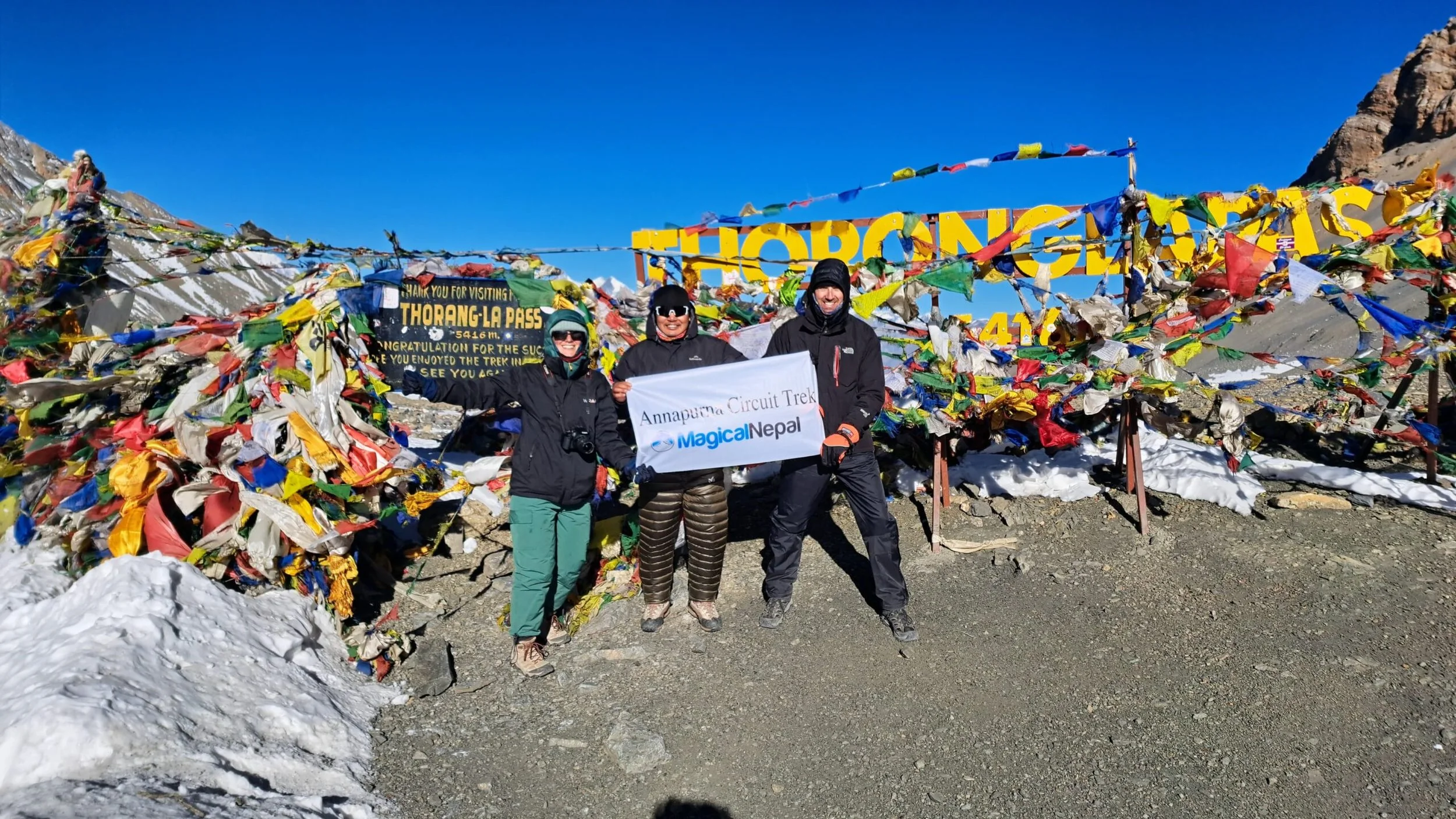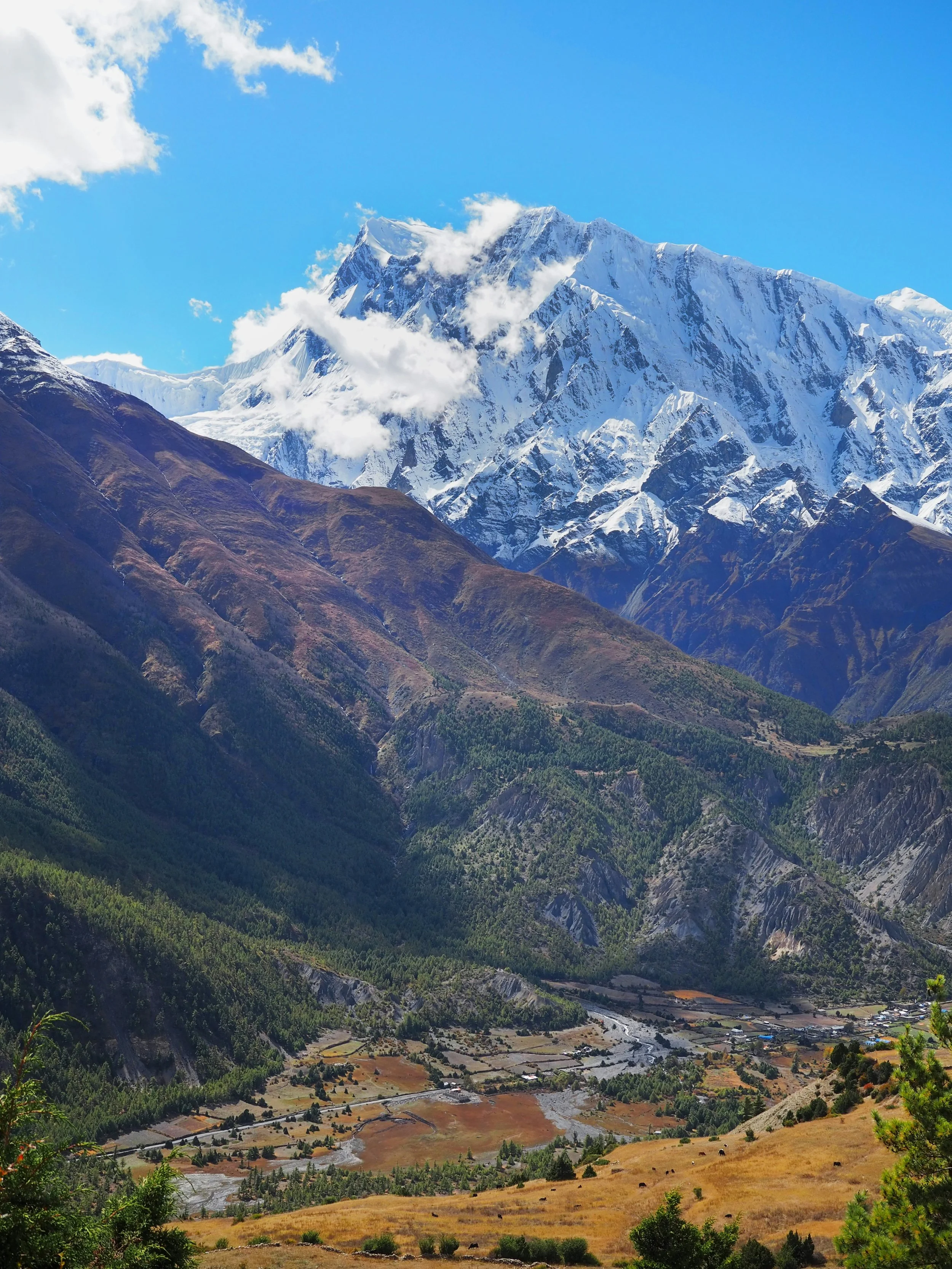Annapurna Circuit Trek in Monsoon Season: What to Expect + Tips (2025 Guide)
Disclosure: This post was written in collaboration with Magical Nepal and also contains affiliate links, which means if you click and make a purchase, I may earn a small commission at no extra cost to you. As always, I only recommend gear and services I use and trust.
Learn from the trek experts at Magical Nepal what makes trekking the Annapurna Circuit during Nepal’s monsoon season extra special, but also more difficult, plus how to stay safe in the wet terrain.
It’s raining outside your teahouse window. Mist rises from a distant waterfall, rice fields shimmer green below, and the scent of wet earth fills the air. This is the Annapurna Circuit Trek during monsoon season — lush, vibrant, and often overlooked.
While most travelers aim to trek in October or November for clear skies, Nepal’s rainy season (June to August) offers a different kind of beauty — and challenge. So what’s it really like to hike the Annapurna Circuit in the rain? And is it worth it?
In this guide, you’ll learn what to expect if you’re trekking the Annapurna Circuit during monsoon season, from weather patterns and best trail sections to essential gear, safety tips, and alternative routes.
Can You Trek the Annapurna Circuit During Monsoon Season?
Yes — but it comes with trade-offs. Learn how weather, trail conditions, and altitude affect your options.
You can do the Annapurna Circuit Trek during monsoon season, but you must be careful and ready to change your plans if necessary. Nepal’s monsoon season is from mid-June to August. This means heavy rain, hot days, and sometimes landslides.
The lower parts of the trail, like Besisahar, Chame, and the Marsyangdi Valley can be very wet and muddy. Trails can be slippery, and small landslides can block the way. But when you go higher up, near Manang, the weather is often drier. This is because Manang is in a rain-shadow area, which means the big mountains block some of the rain clouds.
So yes, some parts of the Annapurna Circuit are still trekkable in the monsoon season, but you should always go with a guide who knows the trails well and can help you stay safe.
Pros of Doing the Annapurna Circuit Trek in Monsoon Season
Photo Courtesy of Magical Nepal
Lush scenery, fewer crowds, cultural experiences, and flowing waterfalls — some trekkers prefer the rain.
The monsoon season has its own special beauty. The valleys are electric green and full of flowers. You will see farmers planting rice and millet, while waterfalls gush big and strong and the rivers are loud and exciting.
There are fewer trekkers on the trail, so you are more likely to snag nicer rooms in the tea houses along the way, and you’ll have more opportunities to visit with local families and see firsthand how they live during the rainy season. Watch the kids run and play in the rain while the goats graze in the hills.
You might even have the opportunity to join a local festival like Ropai Jatra (Paddy Planting Festival), where people sing, dance, and play in the muddy rice fields!
Cons and Challenges of Monsoon Trekking in Nepal
Way to Manang Bhraga - Photo Courtesy of Magical Nepal
From muddy trails to leeches and limited mountain views, here’s what you’ll want to prepare for.
Trekking during the monsoon season is not always easy. The trails can be very muddy and slippery, so be sure to pack good boots and to take each step carefully. In the forests, you might even run into leeches that might stick to your skin, so a special pair of leech socks will be quintessential to stop them.
Heavy rain can also make small rivers rise fast, so listen to your guide and be careful when crossing. Landslides, too, sometimes block roads or trails, so you may be asked to wait or take a new path.
It’s possible you and your clothes will struggle to fully dry between the rain and the heavy humidity. It’s a good idea to pack dry bags and extra warm clothes to stay comfortable.
Finally, trekking during Nepal’s monsoon season might mean that you’re not able to see the mountains every day. Sometimes the peaks can hide behind clouds for days.
Best Sections of the Annapurna Circuit for Monsoon Trekking
Thorang La Pass - Photo Courtesy of Magical Nepal
Explore rain-shadow zones like Manang and Thorong La where the weather is drier and more stable.
Some parts of the Annapurna Circuit sit in the rain-shadow zone, meaning they get far less rain than lower regions. From Manang up toward Thorong La Pass, conditions are often drier and more stable.
Trekking the full circuit in monsoon season can be tough, so many trekkers choose a shorter itinerary focusing on the drier sections. For example, you might jeep to Chame or Manang, trek through the rain-shadow areas, then cross Thorong La and exit via Jomsom.
Upper Mustang is another famous rain-shadow region that pairs well with monsoon trekking. It’s culturally rich, arid, and largely untouched by heavy rains—an excellent plan B.
Safety Tips for Trekking the Annapurna Circuit in Monsoon
Stay safe with these key precautions on river crossings, gear, weather planning, and local guides:
Go with a guide: Local guides know the latest trail conditions and can reroute you safely if there’s a landslide or roadblock.
Check the forecast daily: Weather changes fast. Plan flexible days.
Gear up for wet weather: Pack reliable and essential travel gear like a rain jacket, pack cover, quick-dry clothes, waterproof boots, and leech socks.
Stay on known routes: Avoid shortcut trails that might be unstable.
Watch out for rivers: Heavy rain can cause streams to swell. Always cross safely.
Best Alternative Treks in Nepal During Monsoon Season
If mud and leeches don’t excite you, consider a different region altogether. Mustang and Dolpo, both in Nepal’s trans-Himalayan rain-shadow, are classic monsoon trekking destinations. Think arid valleys, ancient Tibetan culture, and barely a drop of rain.
Another lush option? The Langtang Trek. While Langtang does get rain, its trails are less exposed to big landslides than the lower Annapurna sections, and the forests look spectacular in the monsoon season. Plus, it’s shorter, making it perfect if you only have a week or so.
Who Should (and Shouldn’t) Trek the Annapurna Circuit During Monsoon Season?
If you’re an experienced trekker who loves solitude, doesn’t mind getting muddy, and is flexible with your route, the Annapurna Circuit during the monsoon months can be a lush, unforgettable adventure.
But if this is your first trek in Nepal or you want guaranteed mountain views, it’s probably better to stick to the classic season (October–November) or explore rain-shadow regions instead.
FAQ: Annapurna Circuit in Monsoon Season
Q: Is the Annapurna Circuit safe during monsoon season?
A: It can be safe with a knowledgeable guide, but landslides, slippery trails, and swollen rivers can pose challenges.
Q: What month is best for trekking the Annapurna Circuit during the monsoon?
A: Late July and August tend to be more stable in higher regions like Manang and Mustang.
Q: Can beginners trek the Annapurna Circuit in monsoon season?
A: It’s not recommended for first-timers due to weather unpredictability and trail conditions.
Conclusion: Is Monsoon Trekking in Nepal Worth It?
Monsoon trekking in Nepal, especially on the Annapurna Circuit, is all about trade-offs. Yes, you’ll get rain and clouds, but you’ll also find greenery, waterfalls in full roar, and tea houses that feel peaceful and quiet.
If you’re up for the challenge, go with an open mind and a flexible plan. Stay updated on local conditions, pack wisely for the weather, and be ready to adapt your route if needed.
Whatever you choose, remember: trekking in the Himalayas is always an adventure and sometimes the rain brings the most unexpected moments of magic.
About Magical Nepal
Magical Nepal is a leading trekking and adventure travel company based in Kathmandu, Nepal. Founded in 2015, the company specializes in guided treks, cultural tours, and mountain expeditions across the Himalayas, including iconic routes like the Annapurna Circuit, Everest Base Camp, and Upper Mustang. With a deep commitment to sustainable tourism and local expertise, Magical Nepal has helped thousands of travelers experience the beauty and spirit of Nepal's mountains, villages, and traditions through safe, well-organized adventures led by experienced local guides.
Travel Resources That Give Back to the Blog
This blog survives and thrives on affiliate links, but only ones I’ve trip-tested and would recommend myself. This means that with every purchase you make through my links, I receive a small commission at no additional cost to you. Thanks for your support!
From twisted ankles to lost bags to last-minute itinerary changes, monsoon trekking in Nepal adds a layer of unpredictability. World Nomads offers flexible travel insurance built for adventure — including emergency medical, trip interruption, and gear coverage. For remote treks like the Annapurna Circuit, it’s just smart peace of mind.
Cell signal can be spotty in the mountains, but when you hit a village with service, having data is a lifesaver — whether to check the forecast, stay in touch, or update your location. Saily makes it easy to grab an eSIM before you land in Nepal, with affordable data plans you can activate instantly.
Whether you're piecing together your own trek or looking to book a guided Annapurna Circuit experience, TripAdvisor helps you compare tour companies, read real traveler reviews, and find trusted guesthouses in Kathmandu and Pokhara. It’s a great planning tool, especially if you're heading into the unknown.
For a full list of recommended travel gear and resources that support the blog, visit my Travel Resources page here.











Learn what to expect if you’re trekking the Annapurna Circuit during monsoon season, from weather patterns and best trail sections to essential gear, safety tips, and alternative routes.